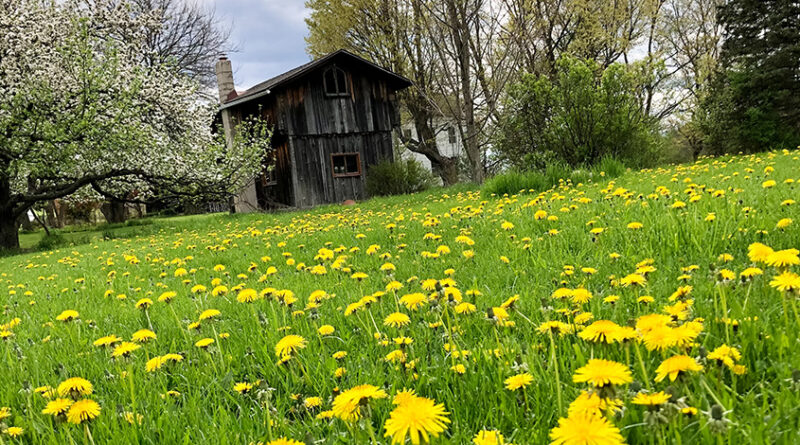Living Together at East Hill Farm
Finger Lake’s art community, home to 12 residents and 35-40 members, thrives in its 56th year
By Melody Burri
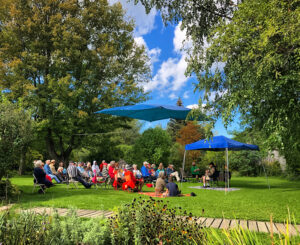 It was 1972 when Annie Schliffer first stepped foot onto East Hill Farm soil. She’d planned to visit the Finger Lakes homestead of The Rochester Folk Art Guild for just one month, but fell so deeply in love that she stayed for the next 50 years.
It was 1972 when Annie Schliffer first stepped foot onto East Hill Farm soil. She’d planned to visit the Finger Lakes homestead of The Rochester Folk Art Guild for just one month, but fell so deeply in love that she stayed for the next 50 years.
Was it the natural beauty of the 350-acre hilltop farm overlooking Middlesex Valley and Canandaigua Lake?
Was it the lifestyle of the Folk Art Guild members’ “intentional community devoted to offering support and nourishment to all who are searching for a more conscious, creative and responsible way of living?”
Was it the impressive cadre of respected artisans whose work ranked among the best in the region?
Was it the members’ shared belief system, centered on the teaching of Greek-Armenian teacher and philosopher G. I. Gurdjieff?
The answer, quite simply, was yes — Yes to it all.
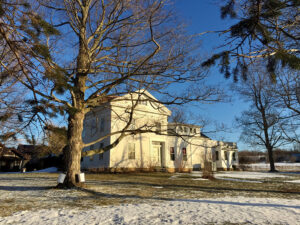 And it’s likely that’s why the Rochester Folk Art Guild is still thriving on a hilltop outside of Naples after all these years.
And it’s likely that’s why the Rochester Folk Art Guild is still thriving on a hilltop outside of Naples after all these years.
“I really don’t know another life at this point,” said the 74-year-old Rochester Folk Art Guild master potter. “I’ve basically grown up here. I met my husband here and we raised our family together here.”
Schliffer said her original intent back in ‘72 was to apprentice as a potter with guild founder Louise March. The RFAG community was just five years into its 56-year history at the time.
She was immediately drawn to the quality of the pottery, but also to the way of working. It emphasized not only the product but also the process that went into making it. What kind of attention should she give to the piece and what kind of care and love would go into it?
“What I discovered is that the teachings of G. I. Gurdjieff gave me clues about how I could go about my work,” she said. “I saw that most of the time I’m acting in a very mechanical, ‘asleep’ way, and that by noticing that, I could start to move myself gently, the same way I learned to center a pot, to center myself and aspire to have more attention and care about what I do.”
Beyond the potter’s wheel, a second aspect of Schliffer’s half-century connection to East Hill Farm is that she fell “deeply in love with the land.”
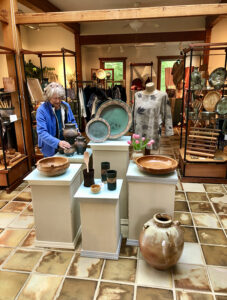 “I’ve watched it over these 50 years and watched the trees grow and the sun shine and the angle of the sun right now because it’s winter,” she said. “I’ve watched the ice freeze and thaw and have gone through all the seasons. I’m very attached and need very much the nurturing quality of nature. That’s just part of who I am. So I walk every day and in the summer I swim in the pond and in the winter I cross-country ski.”
“I’ve watched it over these 50 years and watched the trees grow and the sun shine and the angle of the sun right now because it’s winter,” she said. “I’ve watched the ice freeze and thaw and have gone through all the seasons. I’m very attached and need very much the nurturing quality of nature. That’s just part of who I am. So I walk every day and in the summer I swim in the pond and in the winter I cross-country ski.”
It’s not hard to understand her connection and passion.
The setting is rural and idyllic, the views spectacular and the work fulfilling.
Rochester Folk Art Guild’s 12 residents and 35 or 40 members have an established tradition of organic agriculture, fine craft work and personal development. Projects include organic gardens, orchards and vineyards; food preservation; sustainable forestry; firewood production; grounds maintenance and construction.
The farm boasts multiple meeting and residential buildings and art studios for daily life, cooking and sharing meals, creating art and pursuing personal development.
East Hill Gallery, which is front and center at the farm, showcases some of those unique crafts made on site by resident artists, including turned wooden bowls, toys and furniture, glass jewelry, hand-sewn clothing, handwoven scarves and ponchos, stoneware and porcelain pottery, eco-printed pieces, stationery, greeting cards, books and original musical recordings.
A short walk from the gallery takes guests into the creative heart of the campus. Well-appointed working studios — each one active, spacious, intuitively laid out and multi-functional — live in separate buildings clustered near the epicenter of the farm.
They’re home to resident artists, their tools and materials, and often students specializing in graphic arts, natural clothing design, pottery, weaving, woodworking, wooden boat building and repair and more. Step across any of their thresholds and the hum of creativity is palpable.
A few more steps down the lane is weaver Truus Radin’s loft studio. She began her relationship with RFAG more than 40 years ago, and before she began weaving in 2000, she served as a cook and also a shepherd for some 20 years. Radin said at the guild she enjoys the independence and freedom to make what she wants in the way she wants and can work flexible hours to create her colorful wool scarves and wraps. In her secluded second-floor studio, she can “go weeks without seeing anyone,” or may have fellow artists drop in for a visit. It’s a rhythm that feeds her creative spirit.
Connected by purpose
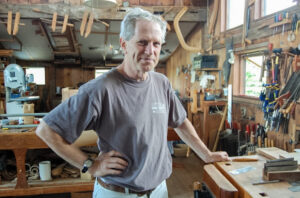 Master woodworker David Barnet came to East Hill Farm in 1975 after a series of visits. Steeped in a passion for Asian thought, religion, philosophy and language, he had graduated from the University of Rochester with majors in history and Asian studies. Barnet was eager to take the next step beyond exploring “the science of being,” and “how to be in life,” into experiencing it.
Master woodworker David Barnet came to East Hill Farm in 1975 after a series of visits. Steeped in a passion for Asian thought, religion, philosophy and language, he had graduated from the University of Rochester with majors in history and Asian studies. Barnet was eager to take the next step beyond exploring “the science of being,” and “how to be in life,” into experiencing it.
RFAG’s spiritual community became his new home, and its members became his adopted family.
But that change came with continued adjustments.
“Working and living in community is not a simple path, like rolling downhill,” said Barnet. “It’s always a sacrifice because there are elements that are uncomfortable, that require compromise and accommodation and reconciliation with other people. That is something that one learns and develops a taste for. And you either accept it or not.”
Nearly 50 years later, he still lives on site, contently, with a core group of about 12 people. In addition to woodworking, Barnet also manages the orchards and the guild’s publicity.
“When you throw your lot in with a group of people, they’re not necessarily the people you would have chosen to live with,” said Barnet. “But there’s a kind of a gravitation toward the same aim and that unites the people together. In a way, it is a family, but not a family by blood.”
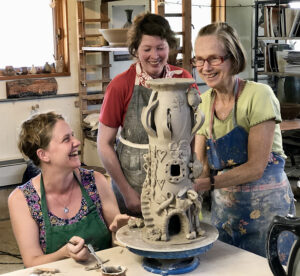 Schliffer said she treasures the opportunity to be able to cook for one another and gather for meals each day.
Schliffer said she treasures the opportunity to be able to cook for one another and gather for meals each day.
“It’s just wonderful to be able to share not only resources, because it’s much cheaper to cook for 10 or 12 or 15 people than one, but also enjoy the feeling of community coming together,” she said.
Schliffer said she bakes 13 loaves of bread once each week and loves it.
She raised her kids to bake as well. So it was especially rewarding when Schliffer’s youngest son, after going off to college and traveling around the world, came back and became a “super good artisan bread baker.” For a time he even took over his mom’s role as the guild’s main breadmaker.
“But then you have the challenges — this person leaves a mess here, that person makes something that tastes all wrong, who’s going to clean up. Group living isn’t easy,” said Schliffer. “It has its challenges — it’s not all hunky dory. But life isn’t. You work on it. You work to not judge that person because they left a mess.”
More than creativity
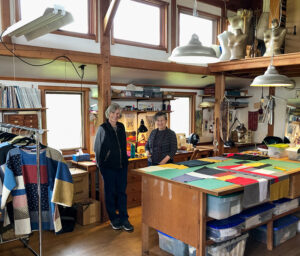 Even at first glance, it’s obvious that life at East Hill Farm provides an ideal climate for artists to birth new ideas and stoke their creative fires.
Even at first glance, it’s obvious that life at East Hill Farm provides an ideal climate for artists to birth new ideas and stoke their creative fires.
For instance, Barnet may take inspiration from a pattern that Schliffer uses in the pottery studio and adapt it as a wood carving on a turned bowl.
But for guild members, community life is really more about character growth and inner development than anything else. It’s not so much about becoming a more proficient or capable artist, Barnet said. It’s about becoming a more complete, considerate person.
And there’s a deep-rooted respect for the “we” in the creative process, rather than the “I,” he said. Yes, there is a wonderful opportunity for artists to express themselves, but it’s not the end in itself.
“The guild members don’t sign their names to their work, we just put a guild symbol on it or write Rochester Folk Art Guild rather than our own names,” said Barnet. “And that is emblematic of indicating that I’m not the sole maker of the piece. I’m just a part of the process. So that is more honest provenance than saying ‘this is all about me.’”
Guild members agree that the creative process is a collaboration between the artist, the community and all of the natural processes that produced the tree or the clay or the wool.
A Look Ahead: Commune at East Hill Farm Turns 56
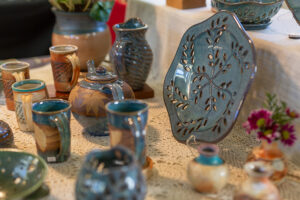 With preliminary groundwork laid in 1957 and the East Hill Farm dream realized in 1967, the Rochester Folk Art Guild is now in its 56th year.
With preliminary groundwork laid in 1957 and the East Hill Farm dream realized in 1967, the Rochester Folk Art Guild is now in its 56th year.
Guild members know the nonprofit is reaching an important crossroads, said master woodworker David Barnet. They’d like to see the guild position itself to be “a place of sanctuary and refuge — a haven for developing stability in today’s world.”
“And to that end,” Barnet said, “we’re working on the infrastructure to make the place safer and more accessible to outside groups that want to use the beautiful indoor and outdoor spaces that we have, and avail themselves of the place as a retreat center, for workshops and retreats. Not so much for weddings, but for gatherings where people want to get together and further their connection with each other.”
And like a favorite pair of blue jeans, old leather boots, fine wine and friendships, the founding East Hill Farm residents have aged well over time. But the dream doesn’t have to end with them.
“We’re realizing that all of us — the older members are in their 70s — are getting older,” said Schliffer. “And if we’re going to have this farm continue past our time, we need to make all of these capital improvements.”
Soon guild members will welcome a new, young family with a 2-year-old into the resident community, Barnet said. They hope it marks the start of more growth to come.
“We need to replace ourselves,” said Schliffer.
Experience it Firsthand
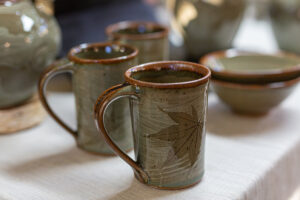 Carrying a longstanding tradition into the future, the Rochester Folk Art Guild continues to open their studio doors for public tours and to offer multiple apprenticeships, internships and summer craft weekends for various ages and in assorted formats. These are open to interested members of the public.
Carrying a longstanding tradition into the future, the Rochester Folk Art Guild continues to open their studio doors for public tours and to offer multiple apprenticeships, internships and summer craft weekends for various ages and in assorted formats. These are open to interested members of the public.
• Apprenticeships in the areas of pottery, woodworking and wooden boat restoration last one to three years and offer a practical, hands-on approach to learning and living.
Apprentices take part in the daily life of the community, sharing in meal preparation, cleaning, maintenance, farming and gardening as well as the seasonal celebrations and special events.
Study of the Gurdjieff teaching is available to apprentices, but is not required.
• Internships are offered in the various craft disciplines and in community life for those interested in shorter stays at the guild.
Summer interns work alongside guild members in the areas of organic gardening, orchards, cooking, food preservation and storage with an emphasis on agriculture.
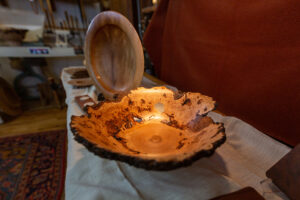 • Craft Weekend is offered from Aug. 10 through 13 for school-aged children through adults. Courses often include filmmaking, pottery, weaving, woodturning, poetry, indigo vats and shibori and earth camp.
• Craft Weekend is offered from Aug. 10 through 13 for school-aged children through adults. Courses often include filmmaking, pottery, weaving, woodturning, poetry, indigo vats and shibori and earth camp.
Attendees enjoy 15 hours of studio time and instruction, kicked off by a welcome dinner and celebration of creativity at the close.
This is popular for individuals, friends or parents and children to attend and take the same or different courses, Barnet said. Options are available for guests depending on age and housing needs.
• Classes in various disciplines are offered throughout the year to members of the public, including but not limited to group pottery, fiber work, reiki healing, Iyengar and chair yoga, orchard workshops, sourdough bread baking and woodturning.
RFAG programs are made possible by the New York State Council on the Arts with the support of the Office of the Governor and the New York State Legislature.
For information on classes, event space rental or apprenticeships and internships, visit www.folkartguild.org, call 585-554-3539, email info@folkartguild.org or find @TheFolkArtGuild on Facebook.
About the Guild
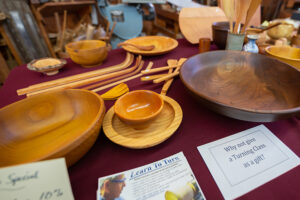 The Folk Art Guild is an intentional community and craft center located in Middlesex. For 56 years, guild artisans have been producing fine crafts including pottery, woodworking, weaving, natural fiber clothing and folk toys.
The Folk Art Guild is an intentional community and craft center located in Middlesex. For 56 years, guild artisans have been producing fine crafts including pottery, woodworking, weaving, natural fiber clothing and folk toys.
Membership includes both non residents and residents who live on site year-round, sharing meals and working together in an effort to live more sustainably.
As a nonprofit institution, the guild offers education in traditional crafts through classes, residencies and apprenticeships.
The 350-acre farm is home to the East Hill Gallery, open May through October and displaying the work of guild artists.
The Folk Art Guild is part of an international network of groups studying the teachings of G. I. Gurdjieff.
Daily Life
Awareness
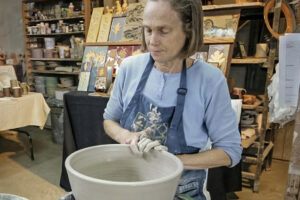 Guild members seek to pay close attention to what is happening in both their inner and outer worlds as each day unfolds. Striving to cultivate a finer quality of attention, they acknowledge the diverse impulses that arise inside them. This can ultimately bring a greater sense of inner balance and relatedness with themselves, others and the world.
Guild members seek to pay close attention to what is happening in both their inner and outer worlds as each day unfolds. Striving to cultivate a finer quality of attention, they acknowledge the diverse impulses that arise inside them. This can ultimately bring a greater sense of inner balance and relatedness with themselves, others and the world.
Practical Work
Work is a laboratory where guild members learn about the laws of nature, about their own desires and resistances, and about interacting with others. The challenge of working with crafts, farming and other natural processes can be a great help.
Working with Our Hands
When the mind and the body together find the corresponding rhythm of work, guild members feel closer to their sense of being alive and the purpose of their time here on earth. With their hands and body, they plant the seed in the soil, knead the bread in the kitchen and pull a pot from a mound of clay. When the mind is open and attentive, not interfering but rather quietly interacting with the intelligence of the hands and body, the heart awakens to a new understanding.
Living with Others
Guild members celebrate the joys and face the frictions and difficulties of daily life together. With the help of others, they become both a teacher and a student, listening with less judgment and seeing some of their own shortcomings. Through personal effort combined with mutual support, cooperation and trust, they continue to build a community that nurtures all through acts of service, love, encouragement and self discipline.
Meet Guru G. I Gurdjieff
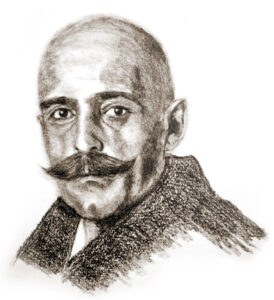 Members of the Rochester Folk Art Guild follow the teachings from Greek-Armenian George Ivanovich Gurdjieff (pronounced GURD-jeef). He was an influential spiritual teacher, writer and musician of the first half of the 20th century.
Members of the Rochester Folk Art Guild follow the teachings from Greek-Armenian George Ivanovich Gurdjieff (pronounced GURD-jeef). He was an influential spiritual teacher, writer and musician of the first half of the 20th century.
He taught that human life as ordinarily lived is similar to sleep. He said transcendence of the sleeping state requires work, but when it is achieved, an individual can reach remarkable levels of vitality and awareness.
Gurdjieff’s legacy of writings, music and movements, or sacred dances, engage the intelligence of body, heart and mind and are studied at the Rochester Folk Art Guild.
According to RFAG master potter Annie Schliffer, making a beautiful pot requires that a person participate in a universal process of awakening the intelligence of the body and the hands. The same forces that shape a pot can also shape a person’s life, she said. As one attends to what one is doing in every moment, simple acts come to have inner meaning.
So it is that guild members all share in community tasks that include cooking, cleaning, gardening, care of animals, building maintenance and general upkeep. These daily chores, the discipline of the crafts, and the practice of music and movements provide opportunities to practice that “attention” and offer a model for transformation.
Gurdjieff’s message is one of hope, that there is the real possibility of evolution and discovering what it means to truly be a human being.

